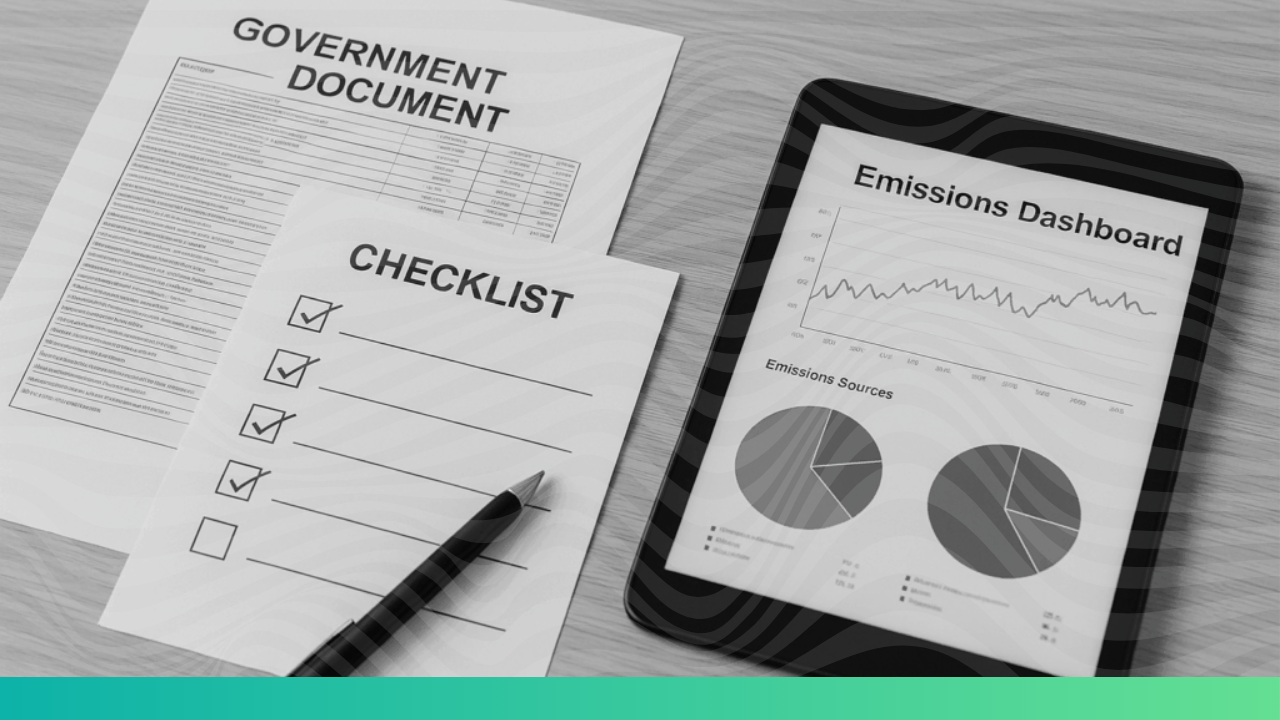If businesses wish to improve their own production processes and activities while also taking into account external issues, they must be carbon-accountable. A crucial tool for companies looking to monitor and cut their greenhouse gas emissions is carbon accounting. Businesses can find opportunities for establishing GHG reduction targets, track progress, and eventually promote corporate sustainability by using a reputable and competent carbon accounting software solution. Any company’s journey toward carbon neutrality and sustainability must start with carbon accounting.
GHG Gases included under the carbon accounting:
- GHG Gases included under the carbon accounting:
- Co2 (Carbon dioxide)
- CH4 (Methane)
- N2O (Nitrous Oxide)
- O3 (Ozone)
- HFC (Hydrofluorocarbons)
- PCFs (Perfluorocarbons)
- SF6 (Sulfur hexafluoride)
What is carbon accounting?
Carbon accounting is the practice of calculating and monitoring greenhouse gas (GHG) emissions and removals in order to determine an entity’s carbon footprint. It entails measuring, figuring out, and disclosing the quantity of carbon dioxide (CO2) and other GHGs released or eliminated as a result of particular operations or activities.
By assessing an organization’s or entity’s contribution to GHG emissions, carbon accounting aims to comprehend and manage its impact on climate change. Organizations can identify their main GHG emission sources and create strategies to decrease or mitigate them by accounting for emissions. Setting goals for emission reduction, monitoring the status, and reporting the outcomes to stakeholders are all made easier with the aid of carbon accounting.
Carbon accounting process:
1. Inventory and Scope determination: Defining the assessment’s parameters by listing the operations, activities, and sources that will be taken into account for emissions or removals.
A. Organizational Boundaries – Organizational boundaries refer to the scope or extent to which an organization includes entities, facilities, or activities in its greenhouse gas (GHG) reporting. It involves defining the organizational entities for reporting emissions as per the Consolidation approach
- Equity-based Approach – Equity shares in GHG accounting involve considering emissions associated with an organization’s equity investments in other companies.
- Financial control – A corporation is responsible for all GHG emissions from operations over which it has financial control under the financial control approach.
- Operational Control – Under the operational control approach, a company accounts for all emissions from operations over which it or one of its subsidiaries has operational control.
B. Operational Boundaries – The first step in setting operational boundaries is to determine which sources of emissions should be included in the reporting. on the basis of its business goals, whether to account only for scope 1 and scope 2, or whether to include relevant scope 3 categories for its operations.
- Scope 1 – Direct GHG emissions occur from sources that are owned or controlled by the company, Process Emissions, Stationary Emissions, Fugitive emissions, and mobile combustions, for example, emissions from combustion in owned or controlled boilers, furnaces, vehicles, etc.
- Scope 2 – Scope 2 emissions are indirect emissions resulting from purchased energy (electricity, heat, steam, and cooling). They are associated with the energy consumed by an organization but not generated on-site.
- Scope 3 – Scope 3 emissions are indirect emissions beyond an organization’s control, occurring throughout the value chain. They include the upstream and downstream emissions.
2. Baseline and target set: A base year is a period of time that can be used to compare current emissions. The baseline year should be set according to the industry’s future goals. The baseline could be selection could be 2 types:-
- Fixed base year: In a fixed base year, the reference year for each succeeding year is the same year.
- Rolling base year: The reference year is updated yearly in a rolling base year. As a result, the base year is always the year prior.
The Science Based Targets Initiative (SBTi): Defines and promotes best practices to set GHG emission targets and emissions reductions in line with climate science.
3. Data Collection: Collect information on the use of energy, fuel, production levels, transportation, waste management, and other essential elements that affect GHG emissions. Various sources of this information, including utility bills, invoices, production records, and activity data, can be used to gather it.
4. Emission Collection: The gathered information is transformed into GHG emissions using recognized emission factors or models. The quantity of GHGs released per unit of activity or fuel consumed is represented by emission factors. Each emission source and type of GHG, such as CO2, methane (CH4), and nitrous oxide (N2O).
5. Conversion to Co2 Equivalent: Different GHGs have varying warming potentials, which means they affect the climate differently during a specific time period. By multiplying the emissions of each gas by its own global warming potential (GWP), emissions from various GHGs are aggregated and compared as CO2e.
6. Reporting and Verification: Disseminating reports and disclosures that detail the outcomes of the carbon accounting process. The computed emissions, emission reduction objectives, plans, and other pertinent data are often included in these reports. For credibility and openness, certain organizations may opt to have their emissions statistics independently validated.
Why do we need Carbon Accounting?
- Climate Change Mitigation: We can establish reduction goals and create plans to successfully mitigate climate change by quantifying emissions.
- Transparency and Accountability: A standardized and open technique for calculating and reporting emissions is provided by carbon accounting. This enables businesses to take responsibility for their environmental effect and emission reduction efforts. Stakeholders can also evaluate and contrast the environmental performance of other organizations.
- Policy Development and Compliance: Data on carbon accounting is essential for guiding the creation of laws and policies addressing climate change. This information can be used by governments and international organizations to evaluate the success of current policies and develop new ones that will effectively control emissions. Organizations use carbon accounting to demonstrate adherence to regulatory standards as well as to satisfy obligatory reporting requirements.
- Resource efficiency and Cost Savings: The identification of high emission and inefficient locations inside enterprises is aided by carbon accounting. Organizations can put measures in place to increase efficiency and lower costs by evaluating energy use, waste production, and resource usage. Initiatives to save energy frequently produce large long-term cost savings.
- Risk Management: Organizations can evaluate and control the risks associated with climate change by using carbon accounting. Organizations can create plans to reduce risks and increase resilience by evaluating their carbon footprint and exposure to climate-related hazards, such as extreme weather occurrences or regulatory changes.
- Stakeholder Expectations: Businesses are under increasing pressure from customers, shareholders, staff, and communities to be environmentally conscious. Organizations can demonstrate their commitment to sustainability and fulfill stakeholder expectations by using carbon accounting. It can improve reputation, draw in environmentally sensitive clients, and get access to chances for sustainable investment.
- Innovation and Competitive Advantage: By incentivizing businesses to create low-carbon technologies, procedures, and goods, carbon accounting promotes innovation. In a world where sustainability is increasingly influencing consumer preferences and market preferences, firms can gain a competitive edge by proactively decreasing emissions and embracing sustainable practices.
- Supply Chain Management: Carbon accounting involves emissions from a company’s supply chain in addition to its direct emissions. Organizations can find opportunities for collaboration, efficiency gains, and emissions reductions throughout the supply chain by understanding the carbon footprint of their suppliers.
- International Reporting and Collaboration: The greenhouse gas protocol and other global reporting frameworks are supported by carbon accounting. Global collaboration in addressing climate change, sharing best practices, and supporting group action to meet global emissions reduction targets are made possible by consistent measurement and reporting.
- Digitize your sustainability data: By digitizing your sustainability data using our platform, you can lower the risk of data loss and guarantee that it will always be accessible for audits and examinations in the future. Your sustainability data’s veracity and integrity are guaranteed.
Overall, managing climate change, increasing resource efficiency, satisfying stakeholder expectations, abiding by rules, and promoting sustainable innovation all depend on carbon accounting. It offers a base for businesses and policymakers to make wise choices, monitor development, and work toward a future that is more sustainable and low-carbon.
Pragya Bargoti




